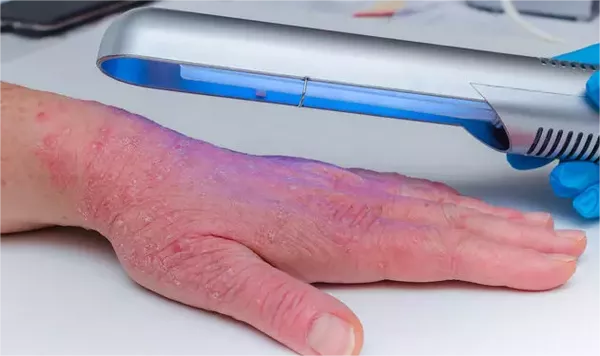For those grappling with the discomfort of psoriasis and its persistent symptoms, psoralens therapy might offer a potential solution. Dermatologists often recommend psoralens in conjunction with ultraviolet A (PUVA) therapy to alleviate the plaques and lesions associated with psoriasis and psoriatic arthritis. This article delves into the mechanism, application, and efficacy of psoralens therapy, providing insights from experts on who might benefit most from this treatment.
What Are Psoralens?
Psoralens are photosensitizing chemicals derived from plants, utilized in light therapy to address various skin conditions. Found naturally in the seeds of Psoralea corylifolia and other plants, psoralens have a long history of medicinal use, dating back to the 1950s in the United States.
PUVA Therapy Explained
PUVA stands for psoralens plus ultraviolet A, a type of phototherapy that combines medication with light, also known as photochemotherapy. Ultraviolet light is categorized into ultraviolet C, B, and A rays. “Psoralens are used in PUVA to treat conditions like psoriasis, eczema, and vitiligo,” explains Dr. Shoko Mori, a dermatologist at Northwell Lenox Hill Hospital in New York City. When psoralens are exposed to UVA light, they trigger changes in the skin and immune system that help manage these conditions.
Applications of Psoralens Therapy
1. Psoriasis: According to Dr. Chris Sayed, an associate professor of dermatology at the University of North Carolina at Chapel Hill, PUVA therapy is more effective than older UV light treatments for psoriasis. Multiple studies highlighted in the Journal of the American Academy of Dermatology support the significant improvement PUVA brings to psoriasis symptoms.
2. Vitiligo: In vitiligo, characterized by depigmented skin patches, PUVA therapy has shown success in re-pigmentation, although results may take six to 12 months to manifest fully.
3. Eczema: PUVA is used for moderate to severe eczema in both children and adults, with studies indicating symptom improvement after 12 weeks. For localized eczema, topical PUVA treatments are preferred to avoid systemic side effects like nausea.
4. Alopecia Areata: PUVA therapy has demonstrated significant hair regrowth in alopecia areata patients, though it can increase scalp sensitivity to sunlight post-treatment.
5. Cutaneous T-Cell Lymphoma: Since 1976, PUVA has been effective in treating certain types of skin cancer, particularly cutaneous T-cell lymphoma.
Administration of Psoralens Therapy
Psoralens can be administered in several ways, depending on whether a systemic or topical treatment is prescribed. These include:
- Bathing or soaking the body or specific areas in a psoralen solution
- Applying psoralen gel or cream to affected areas
- Taking psoralens orally in pill form
- Receiving psoralen injections
Eligibility for PUVA Treatments
While PUVA has proven effective for psoriasis, insurance coverage can vary. It’s crucial to discuss reimbursement options with your doctor or insurance provider beforehand. PUVA is typically reserved for cases where conventional treatments have failed. However, it’s not suitable for individuals with sunlight-sensitive skin disorders, pregnant or lactating women, those with a history of melanoma or multiple non-melanoma skin cancers, or those taking sun-sensitizing medications.
Preparing for PUVA Therapy
PUVA therapy is usually conducted in an outpatient dermatology clinic. Initial treatments might require two to three sessions per week for several months. Your dermatologist will provide specific instructions, including any necessary prescriptions for systemic or topical psoralens. It’s important to inform the medical staff about any new medications or potential pregnancy before starting treatment.
Aftercare for PUVA Therapy
Post-treatment care is essential to manage side effects and enhance treatment effectiveness. Recommendations typically include:
- Avoiding sunlight exposure and using sunscreen for 24 hours
- Refraining from applying perfumes or colognes directly on the skin
- Avoiding scrubbing or tearing the skin
- Abstaining from sunbathing during the treatment phase
- Keeping the skin moisturized
- Limiting the use of nail polish and makeup on treated areas
Effectiveness and Risks
A 2024 review confirms the efficacy of PUVA therapy for psoriasis, with clinical trials over the past 30 years supporting its success in symptom clearance. PUVA is particularly noted for its low withdrawal rate, indicating high patient satisfaction and compliance. However, long-term use increases the risk of non-melanoma skin cancers, such as basal cell carcinoma and squamous cell carcinoma, necessitating regular monitoring.
Conclusion
PUVA therapy, which combines psoralens with ultraviolet A light, offers a potent treatment option for psoriasis and other skin conditions. While effective, it requires careful administration and aftercare to manage short-term risks and monitor for potential long-term effects. Always consult with your dermatologist to determine the best treatment plan for your condition and ensure regular follow-ups to mitigate risks.
Related Topics:
- Deciphering Atopic Dermatitis Therapy Options
- Deciphering Shingles: Unveiling the Viral Infection and Its Symptoms
- Advocacy Group Calls for Free Shingles and RSV Vaccines for B.C. Seniors



























